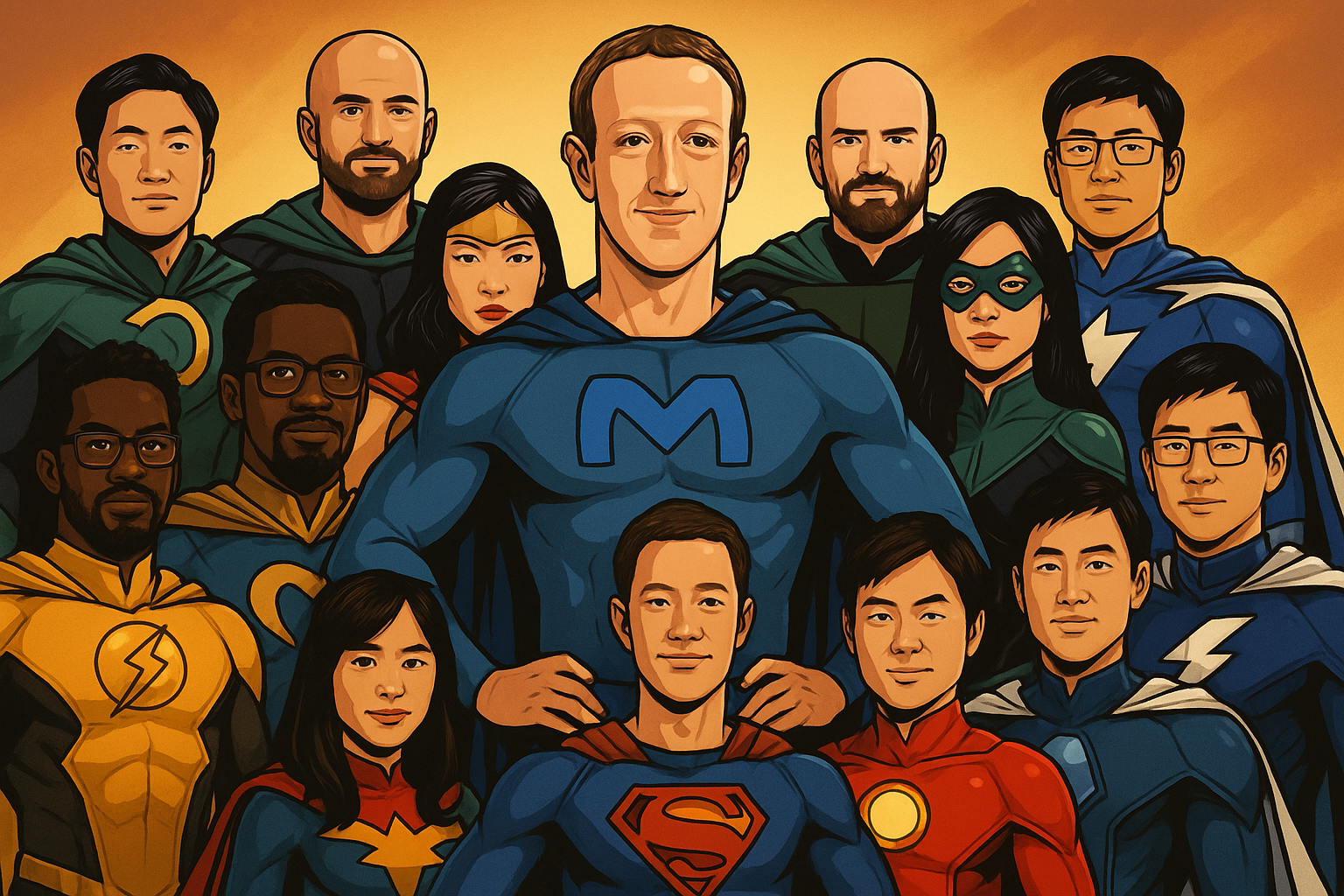Meta’s Superintelligence Labs Just Hired the Avengers of AI
It’s official: Mark Zuckerberg is going all-in on AGI, and he’s not doing it quietly.
The new Meta Superintelligence Labs (MSL) isn’t just another AI moonshot team. It’s a handpicked crew of some of the most influential minds behind GPT-4o, Gemini, Gopher, Chinchilla, and even Waymo’s AI stack. If it feels like Zuck just assembled the Marvel Cinematic Universe of AI researchers… you’re not far off, even if that analogy does make me a little sick in my own mouth.
Let’s unpack why this matters, who these hires are, and what the implications might be - both for Meta and for the broader AGI race.

The Dream Team: Who They Are and Why They Matter
Meta’s latest hires include:
- Trapit Bansal: Key to OpenAI’s reasoning evolution and the o-series of models.
- Shuchao Bi & Ji Lin: Voice and multimodal masterminds behind GPT-4o.
- Huiwen Chang: Vision AI innovator, creator of MaskGIT and Muse.
- Jack Rae: Gemini and Gopher architect from DeepMind—these are the models that made OpenAI nervous.
- Pei Sun: The brains behind DeepMind’s post-training stack and Waymo’s last two generations of perception models.
- Joel Pobar: A veteran of Meta’s own AI infra, now returning with fresh insight from Anthropic.
- Shengjia Zhao & Jiahui Yu: LLM scaling and perception leads, with fingerprints across OpenAI and DeepMind’s best work.
And at the helm:
- Alexandr Wang, former Scale AI CEO, is now Meta’s Chief AI Officer.
- Nat Friedman, former GitHub CEO and AI investor, leads product and applied AI.
TL;DR: They’ve hired the people who built GPT-4o, Gemini 2.5, Chinchilla, Muse, and more. This isn’t a speculative bet—Meta is acquiring proven execution.
What Sets This Apart From Other AI Efforts
Most Big Tech AI teams operate in silos: research here, infra there, applied product over there.
MSL feels different. It’s interdisciplinary by design, with top-tier talent from:
- Language Models (LLMs)
- Multimodal (voice, vision, code)
- Reasoning
- Inference Infrastructure
- Autonomous Perception
And most of them have built not just models, but the systems and training pipelines that made those models successful. This matters more than it sounds. Training a performant LLM isn’t just about size - it’s about architecture, data curation, post-training techniques, and efficiency. These folks have done all that, repeatedly.
Meta isn’t scrimping here either, with their chequebook open wide and reportedly offering up to $100 million in signing packages, making this arguably the most aggressive AI talent acquisition push we’ve ever seen.
Why This Changes the AGI Race
This isn’t just “catch-up with OpenAI” energy anymore.
It’s:
- Rebuild the foundation of Meta’s AI from the ground up, with people who’ve done it at the highest level.
- Leapfrog competitors by focusing on general-purpose intelligence that works across voice, image, code, and reasoning.
- Push into infrastructure that supports rapid iteration and deployment at Meta-scale.
This puts pressure not just on OpenAI and Google, but on everybody - from Anthropic and Mistral to xAI and Apple. In fact, this might accelerate moves toward closed ecosystems as these labs fight for talent and hardware.
Zuckerberg is playing for the long game - and doing so very publicly.
So… What Should We Be Watching for Next?
Here’s what I’d keep an eye on:
- Custom Foundation Models: MSL will almost certainly train a GPT-4o/Gemini competitor in-house.
- Multimodal UI Experiments: With voice and vision experts on board, expect some bold UI changes in Meta products - possibly even a reimagined AI-first assistant across WhatsApp, Ray-Ban glasses, or VR.
- Open Source or Closed Source?: Meta has flirted with openness (see LLaMA), but this team feels built for internal AGI acceleration. We may see that change.
- Integration with Meta’s hardware: Think Quest, Ray-Bans, or AR glasses becoming more intelligent and interactive - not just for novelty, but as a serious interface for AI.
Final Thoughts
Meta’s new Superintelligence Labs is no hype factory - it’s a strategic, calculated, and well-funded pivot into the most competitive area of tech today.
I wouldn’t be surprised if we look back on this hiring wave in 12 months as the moment Meta went from playing catch-up… to becoming the team to beat in AGI.
This one’s worth keeping a very close eye on.